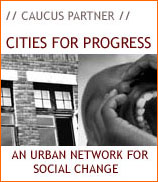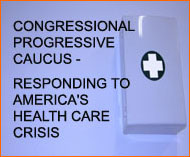
Search
Democratic Leadership
-
Democratic Leadership
Nancy Pelosi
House Democratic Leader
democraticleader.house.gov
Steny Hoyer
Office of Democratic Whip
democraticwhip.house.gov
Democratic Caucus -
US House of Representatives
www.dems.gov
Cost of War in Iraq
-
Cost of War in Iraq
COST OF WAR
IN IRAQ:(JavaScript Error)
Cities For Progress
COngressional Progressive Caucus
Danny K. Davis (IL-07)
The Second Chance Act of 2005
The purpose of the Second Chance Act is to reduce recidivism, increase public safety, and help states and communities to better address the growing population of prisoners returning to communities. The bill will focus on four areas: jobs, housing, substance abuse/mental health treatment, and families.
Prisoner Reentry: The Case for Action
Crime Reduction – Nearly two-thirds of released prisoners are expected to be rearrested for a felony or serious misdemeanor within three years of release. Such high recidivism rates translate into thousands of new crimes each year, at least half of which can be averted through improved prisoner reentry efforts. In 2002, 2 million people were incarcerated in Federal or State prisons. Nearly 650,000 people are released from prison to communities nationwide each year.
Substance Abuse/Mental Health Problems – Seventy to eighty percent of offenders re-entering the community have histories of substance abuse. An increasing number of offenders have mental health problems. If the treatment is not sought or available upon release, relapse is likely. Fifty-seven percent of federal and 70 percent of state inmates used drugs regularly before prison, with some estimates of involvement with drugs/alcohol around the time of the offense as high as 84 percent (BJS Trends in State Parole, 1990 – 2000).
Saving Taxpayer Dollars – Significant portions of state budgets are now invested in the criminal justice system. According to the Bureau of Justice Statistics, expenditures on corrections alone increased from $9 billion in 1982 to $44 billion in 1997. These figures do not include the cost of arrest and prosecution, nor do they take into account the cost to victims.
Strengthening Families and Communities – One of the most significant costs of prisoner reentry is the impact on children and communities. Between 1991 and 1999, the number of children with a parent in a Federal or State correctional facility increased by more than 100 percent, from approximately 900,000 to approximately 2,000,000.
Reducing Recidivism through Common Sense Solutions
· Demonstration Grants. The Second Chance Act reauthorizes the Re-Entry Demonstration project with an enhanced focus on jobs, housing, substance abuse treatment/mental health, and children and families. The bill increases the amount of money to fund demonstration programs and create performance outcomes standards and deliverables.
· National Offender Re-Entry Resource Center. Establishes a resource center for states, local government, service providers, faith-based organization, corrections and community organizations to collect and disseminate best practices and provide training and support around reentry.
· Federal Taskforce. Creates a federal interagency taskforce to identify programs and resources on re-entry, identify ways to better collaborate, develop interagency initiatives and a national re-entry research agenda. The taskforce would review and report to Congress on the federal barriers that exist to successful re-entry with recommendations.
· Offender Re-Entry Research. Authorizes the National Institute of Justice and the Bureau of Justice Statistics to conduct research around re-entry.
· Mentoring Grants to Nonprofit Organizations: Establishes a grant program to provide funding for nonprofit organizations to provide mentoring and transitional services to adult and juvenile offenders.
· Carlie’s Law: In response to Carlie Brucia’s abduction and murder in 2004, the provision requires the automatic revocation of probation or supervised release when a federal felon commits a felony crime of violence against a minor child under the age of 16.
Organizations that Support the Second Chance Act:
1. Access Community Health Network of Chicago
2. Alliance for Children and Families
3. American Academy of Child and Adolescent Psychiatry
4. American Bar Association
5. American Center for Law and Justice
6. American Correctional Association
7. American Counseling Association
8. American Jail Association
9. American Probation and Parole Association
10. American Psychological Association
11. All of Us or None, Oklahoma City, OK Chapter
12. Alston Wilkes Society, South Carolina
13. The Arc of the United States
14. Arizona Statewide TASC: Treatment Assessment & Screening Center
15. Association for Better Living and Education
16. Association of Citizens for Social Reform
17. Association of State Correctional Administrators
18. A T Roseborough & Associated, Inc.
19. BASICS, Inc. - Bronx, New York
20. Big Brothers Big Sisters of America
21. California Association of Alcohol and Drug Program Executives
22. Catholic Charities USA
23. Center for Community Alternatives
24. Center for Community Corrections
25. Center for Employment Opportunities (CEO) - New York
26. Center for Law and Social Policy
27. Center for Youth as Resources
28. Center on Juvenile and Criminal Justice
29. Child Welfare League of America
30. Children's Defense Fund
31. Christian Coalition
32. Church Women United
33. Citizens United for Rehabilitation of Errants - Virginia, Inc.
34. Coalition for Juvenile Justice
35. The Consortium for Citizens with Disabilities Criminal Justice Policy Task Force
36. Corporation for Supportive Housing
37. Correctional Education Association
38. Council of Juvenile Correctional Administrators
39. Covenant House
40. Criminon International
41. D.C. Prisoners’ Legal Services Project
42. Evangelical Lutheran Church in America
43. F.A.C.E. – Baltimore, MD
44. Family Justice
45. Family Research Council
46. Federal Prison Policy Project
47. Federation of Families for Children's Mental Health
48. Fifth Avenue Committee
49. Fight Crime: Invest in Kids
50. Foster Family-based Treatment Association
51. Goodwill Industries International, Inc.
52. Haymarket Center of Chicago
53. Heartland Alliance for Human Needs and Human Right
54. Horizon Faith-based Communities in Prisons
55. Idaho Department of Correction
56. Illinois TASC
57. International Association of Reentry
58. International Community Corrections Association
59. Johnson Institute
60. Justice Fellowship
61. Justice Watch, Inc.
62. Kids First Coalition
63. Leadership Conference on Civil Rights
64. Learning Disabilities Association of America
65. Legal Action Center
66. Lifetrack Resources – Minnesota
67. Local Initiative Support Corporation (LISC)
68. Lutheran Services of America
69. National AIDS Housing Coalition
70. National Alliance for the Mentally Ill
71. National Alliance to End Homelessness
72. National Association of Blacks in Criminal Justice
73. National Association for Children of Alcoholics
74. National Association for Children's Behavioral Health
75. National Association of Counties
76. National Association of Protection and Advocacy Systems
77. National Association of School Psychology
78. National Association of State Alcohol and Drug Abuse Directors
79. National Association of State Mental Health Program Directors
80. National Black Church Taskforce Initiative on Crime and Criminal Justice
81. National Consortium of TASC Programs Inc.
82. National Correctional Industries Association
83. National Council of La Raza
84. National Independent Living Association
85. National Law Center on Homelessness & Poverty
86. National Low Income Housing Coalition
87. National Network for Youth
88. National Religious Affairs Association
89. National Transitional Jobs Network
90. National Urban League
91. New Hope Project – Wisconsin
92. New York City Departments of Correction and Probation
93. New York Therapeutic Communities, Inc.
94. NY TCA
95. North Carolina TASC Training Institute
96. NorthWest Community Corrections Center – Bowling Green, OH
97. Ohio Department of Rehabilitation and Correction
98. Ohio TASC Partnership
99. Physicians for Human Rights
100. Pioneer Human Services –


